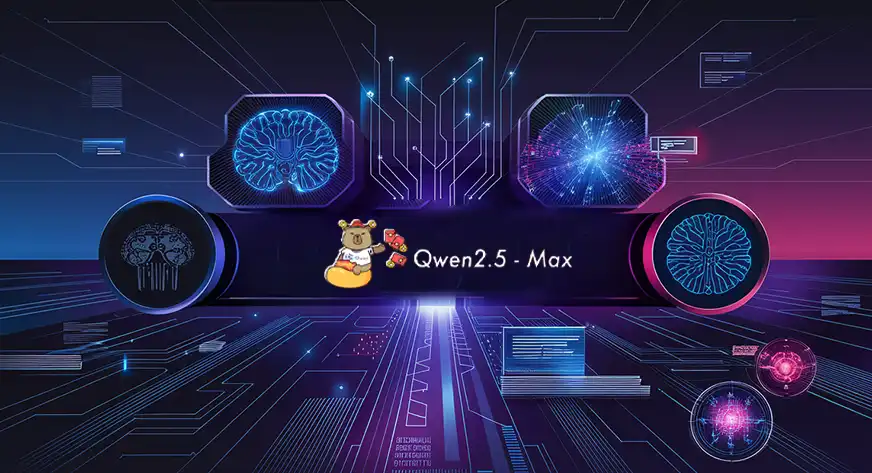Chinese AI lab DeepSeek may be capturing headlines this week, but one of its top domestic rivals isn’t staying quiet. Alibaba’s Qwen team has just unveiled Qwen2.5-VL, a new family of AI models that could shift the balance in the tech industry. With capabilities that span text and image analysis, video comprehension, file parsing, and even software control, Qwen2.5-VL is setting new benchmarks—and it’s doing so with impressive results that rival some of the biggest names in AI.
In this in-depth post, we’ll explore the key features of Qwen2.5-VL, its performance compared to models like OpenAI’s GPT-4o, Anthropic’s Claude 3.5 Sonnet, and Google’s Gemini 2.0 Flash, and the strategic implications for the global AI landscape. We’ll also look at how regulatory factors and licensing differences are shaping its deployment and what these developments mean for the future of AI.
1. A New Era in AI: The Rise of Qwen2.5-VL
1.1. Setting the Stage
Alibaba isn’t new to the AI game, but with Qwen2.5-VL, its ambition is clearer than ever. Unveiled on Monday by the Qwen team, these models are designed not only to analyze text and images but also to tackle tasks that require a deeper understanding of complex data formats—such as videos, charts, and scanned documents. The goal? To provide an AI solution that isn’t just a jack-of-all-trades but a master in multiple domains.
1.2. The Competitive Landscape
Recent benchmarks indicate that the flagship Qwen2.5-VL model outperforms competitors across various evaluations:
- Video Understanding: Outpacing models like GPT-4o and Gemini 2.0 Flash.
- Math and Document Analysis: Excelling in problem-solving and data extraction.
- Question Answering: Delivering more accurate and context-aware responses.
These performance gains have significant implications. In a market where every percentage point of accuracy and speed counts, Qwen2.5-VL is not only a technical achievement—it’s a potential game-changer.
2. Under the Hood: What Qwen2.5-VL Brings to the Table
Alibaba’s Qwen2.5-VL is designed for versatility. Let’s break down its core features:
2.1. Multi-Modal Capabilities
Qwen2.5-VL isn’t just about processing text. It’s built to understand and analyze multiple data types:
- Text Analysis: Natural language processing that enables accurate interpretation and generation of textual content.
- Image and Chart Analysis: The model can parse charts and graphics, making it useful for tasks like data extraction from invoices, forms, and other scanned documents.
- Video Comprehension: Capable of “watching” and understanding videos—an ability that extends to analyzing content over multiple hours.
- Software Control: In a demonstration that highlights its versatility, Qwen2.5-VL has been shown to control software applications on both PCs and mobile devices. For instance, it can launch apps like Booking.com and even book flights, showcasing its potential to interact with digital environments in a practical way.
2.2. Benchmarking Brilliance
The Qwen team has put Qwen2.5-VL through rigorous testing, with the results speaking for themselves:
- Against OpenAI’s GPT-4o: Qwen2.5-VL has shown superior performance in video understanding, math, and document analysis.
- Compared to Anthropic’s Claude 3.5 Sonnet: Qwen2.5-VL takes the lead in question-answering and contextual comprehension.
- Outperforming Google’s Gemini 2.0 Flash: In tasks that mimic real-world scenarios—such as processing and analyzing multimedia content—Qwen2.5-VL scores higher.
These benchmarks suggest that Alibaba’s latest offering could set new industry standards for multi-modal AI performance.
2.3. A Closer Look at Software Control
One of the standout features of Qwen2.5-VL is its ability to interact with software:
- Controlling Applications: A video by Philipp Schmid, technical lead at Hugging Face, demonstrated Qwen2.5-VL launching the Booking.com app on Android and even booking a flight from Chongqing to Beijing.
- Desktop Interactions: Another demonstration showed a Qwen2.5-VL model operating on a Linux desktop—switching tabs and attempting to execute commands. While its performance on comprehensive desktop benchmarks like OSWorld was less impressive, the ability to control software signals exciting potential for future iterations.
3. Navigating Content Moderation and Regulatory Boundaries
3.1. Ensuring “Core Socialist Values”
As a Chinese-developed AI, Qwen2.5-VL comes with built-in content restrictions to ensure compliance with local regulations:
- Regulatory Benchmarks: Chinese internet regulators require AI models to ensure their responses embody “core socialist values.” This means that topics such as Taiwan’s autonomy or criticism of top leaders are automatically off-limits.
- Practical Implications: When asked about “Xi Jinping’s mistakes,” the most capable Qwen2.5-VL model—Qwen2.5-VL-72B—responds with an error message. This is a clear indicator of the tight regulatory oversight governing Chinese AI models.
3.2. Training on Copyrighted Content?
The Qwen team has noted that Qwen2.5-VL can recognize intellectual properties from film and TV series, as well as a wide variety of products. This suggests that the model might have been trained, at least in part, on copyrighted works. Such capabilities raise important questions:
- Content Ownership: How does the model handle copyrighted material?
- Ethical Implications: What are the ramifications for content creators and IP rights?
These are critical considerations, especially as AI models become more integrated into commercial applications.
4. Licensing and Deployment: Who Gets to Use Qwen2.5-VL?
4.1. Two Tiers of Accessibility
Alibaba has adopted a dual-licensing strategy for the Qwen2.5-VL series:
Permissive Licensing for Smaller Models:
The two smaller models—Qwen2.5-VL-3B and Qwen2.5-VL-7B—are available under permissive licenses. This approach encourages experimentation and innovation among developers, as these models can be integrated into various applications with fewer restrictions.Custom Licensing for the Flagship Model:
The flagship model, Qwen2.5-VL-72B, is under a custom license. Companies or developers with more than 100 million monthly active users must request permission from Qwen/Alibaba before deploying it commercially. This strategy is likely designed to:- Control Deployment: Ensure that high-impact implementations are carefully monitored.
- Safeguard Brand and Compliance: Maintain a level of oversight that aligns with both Alibaba’s standards and regulatory requirements.
4.2. Strategic Implications
This licensing approach has several implications:
- Innovation at Scale: The permissive licenses for smaller models can spark a wave of derivative innovations, much like the community-driven projects seen on platforms like Hugging Face.
- Enterprise Readiness: By controlling the deployment of its flagship model, Alibaba can ensure that large-scale implementations meet rigorous safety, ethical, and regulatory standards.
- Market Penetration: Such a licensing model could encourage both startups and established companies to adopt Qwen2.5-VL, knowing they can access state-of-the-art AI while complying with local regulations.
5. Qwen2.5-VL in Action: Real-World Demonstrations
5.1. The Power of Visual and Textual Analysis
Qwen2.5-VL’s multi-modal capabilities are not just theoretical—they’re being demonstrated in real-world scenarios:
- Analyzing Charts and Graphics:
The model can extract data from invoices, forms, and other documents with complex visual layouts. This has potential applications in finance, logistics, and administration. - Understanding Long-Form Videos:
Qwen2.5-VL can “comprehend” videos that run for hours, which is a significant leap in video analysis technology. This capability can revolutionize sectors like media analysis, content moderation, and digital archiving. - Extracting Information from Scanned Documents:
The ability to parse and understand text from scanned documents positions Qwen2.5-VL as a valuable tool in digitization projects and data analytics.
5.2. Software Control: Beyond the Basics
The demonstrations of Qwen2.5-VL controlling software reveal exciting possibilities:
- Mobile Device Interactions:
The AI has been seen launching apps on Android devices, highlighting its potential integration with mobile ecosystems. - Desktop Functionality:
On a Linux desktop, Qwen2.5-VL has been shown to switch between tabs and execute commands—albeit with room for improvement. These early demonstrations hint at a future where AI can serve as an intelligent interface between humans and computers.
While current benchmarks (such as the OSWorld evaluation) indicate that Qwen2.5-VL still has a way to go before it can fully mimic a real user’s interaction with a desktop environment, the progress is undeniably promising.
6. The Global AI Race: Alibaba’s Strategic Moves
6.1. Challenging the Status Quo
The release of Qwen2.5-VL is a clear signal that Alibaba is not just reacting to competitors like DeepSeek—it’s actively shaping the global AI landscape. Here’s how:
- Benchmarking Superiority:
With Qwen2.5-VL outperforming models from OpenAI, Anthropic, and Google in several critical areas, Alibaba is positioning itself as a serious contender in the next generation of AI. - Expanding Use Cases:
The ability to handle diverse tasks—from visual analysis to software control—means that Qwen2.5-VL can be deployed in a wide range of industries, from finance to entertainment. - Domestic and International Influence:
While Qwen2.5-VL’s responses are tailored to comply with Chinese regulations, its technical capabilities make it a competitive product on the global stage. This duality could potentially reshape how AI models are developed, deployed, and regulated worldwide.
6.2. Regulatory Dynamics and Global Implications
As with many Chinese AI products, Qwen2.5-VL operates under strict regulatory guidelines:
- Content Restrictions:
To ensure that its responses align with “core socialist values,” Qwen2.5-VL imposes certain content restrictions. This can limit its use in discussions around politically sensitive topics, which may affect its adoption in some markets. - Data and Copyright Considerations:
The potential use of copyrighted works in its training data raises important questions about intellectual property and data ethics. This is a challenge that global AI developers will need to navigate carefully.
Alibaba’s approach reflects a broader trend in which national priorities and regulatory frameworks play a decisive role in AI development. As global tensions rise around technology and data sovereignty, Qwen2.5-VL’s evolution will be closely watched by policymakers, tech companies, and investors alike.
7. Frequently Asked Questions (FAQ)
Q1: What is Qwen2.5-VL, and what makes it unique?
A: Qwen2.5-VL is a family of multi-modal AI models developed by Alibaba’s Qwen team. It is designed to analyze text, images, videos, and even control software on PCs and mobile devices. Its ability to perform a range of tasks—from parsing invoices to understanding long videos—sets it apart from many current AI models.
Q2: How does Qwen2.5-VL compare to other AI models like GPT-4o and Gemini 2.0 Flash?
A: According to Alibaba’s benchmarking, Qwen2.5-VL outperforms competitors such as OpenAI’s GPT-4o, Anthropic’s Claude 3.5 Sonnet, and Google’s Gemini 2.0 Flash in tasks including video understanding, mathematical problem solving, document analysis, and question answering.
Q3: What are the content restrictions on Qwen2.5-VL?
A: As a Chinese-developed model, Qwen2.5-VL is designed to comply with local regulations. This means it is programmed to avoid discussing politically sensitive topics—such as Taiwan’s autonomy or criticisms of top leaders—and its responses must embody “core socialist values.”
Q4: Can Qwen2.5-VL control software applications?
A: Yes, one of the innovative features of Qwen2.5-VL is its ability to interact with and control software on both PCs and mobile devices. Demonstrations have shown the model launching apps and executing simple commands, though there is room for improvement in real-world performance.
Q5: What licensing options are available for Qwen2.5-VL?
A: Alibaba offers Qwen2.5-VL in two tiers:
- Smaller Models (Qwen2.5-VL-3B and Qwen2.5-VL-7B): These are available under permissive licenses, encouraging experimentation and integration by developers.
- Flagship Model (Qwen2.5-VL-72B): This model is available under Alibaba’s custom license, requiring companies or developers with more than 100 million monthly active users to obtain permission before deploying it commercially.
Q6: Where can I test or access Qwen2.5-VL?
A: Qwen2.5-VL is accessible via Alibaba’s Qwen Chat app and is available for download on the AI development platform Hugging Face, allowing developers to experiment with its capabilities.
8. Looking Ahead: The Future of Qwen2.5-VL and Global AI
8.1. Innovation and Iteration
Alibaba’s release of Qwen2.5-VL marks a significant milestone, but it’s just the beginning. Future iterations are likely to:
- Enhance Multi-Modal Performance: Expect further improvements in the model’s ability to process and analyze diverse data formats.
- Expand Real-World Applications: With software control and multi-domain analysis, upcoming versions could be deployed in industries ranging from healthcare to entertainment.
- Address Benchmark Shortcomings: Although early demonstrations are promising, there is room for improvement—particularly in complex desktop environments as indicated by OSWorld benchmark results.
8.2. Global Competitive Dynamics
Qwen2.5-VL’s emergence is set against the backdrop of fierce competition in the AI space:
- Raising the Bar: With Alibaba’s models outperforming some of the biggest names in AI, companies like OpenAI, Anthropic, and Google will need to innovate faster.
- Regulatory Influences: As different regions adopt varying standards for AI safety and ethics, models like Qwen2.5-VL will serve as case studies in balancing technical prowess with regulatory compliance.
- Market Implications: The licensing strategies and performance benchmarks of Qwen2.5-VL could lead to shifts in how AI models are adopted across industries, influencing everything from consumer apps to enterprise solutions.
8.3. Ethical and Legal Considerations
The path forward for models like Qwen2.5-VL is not without challenges:
- Copyright and Data Ethics: The use of copyrighted works in training data remains a contentious issue, and developers will need to address these concerns transparently.
- Content Moderation: Striking the right balance between regulatory compliance and global usability is critical. Overly restrictive content guidelines might limit adoption in certain markets, while lax moderation could lead to ethical pitfalls.





